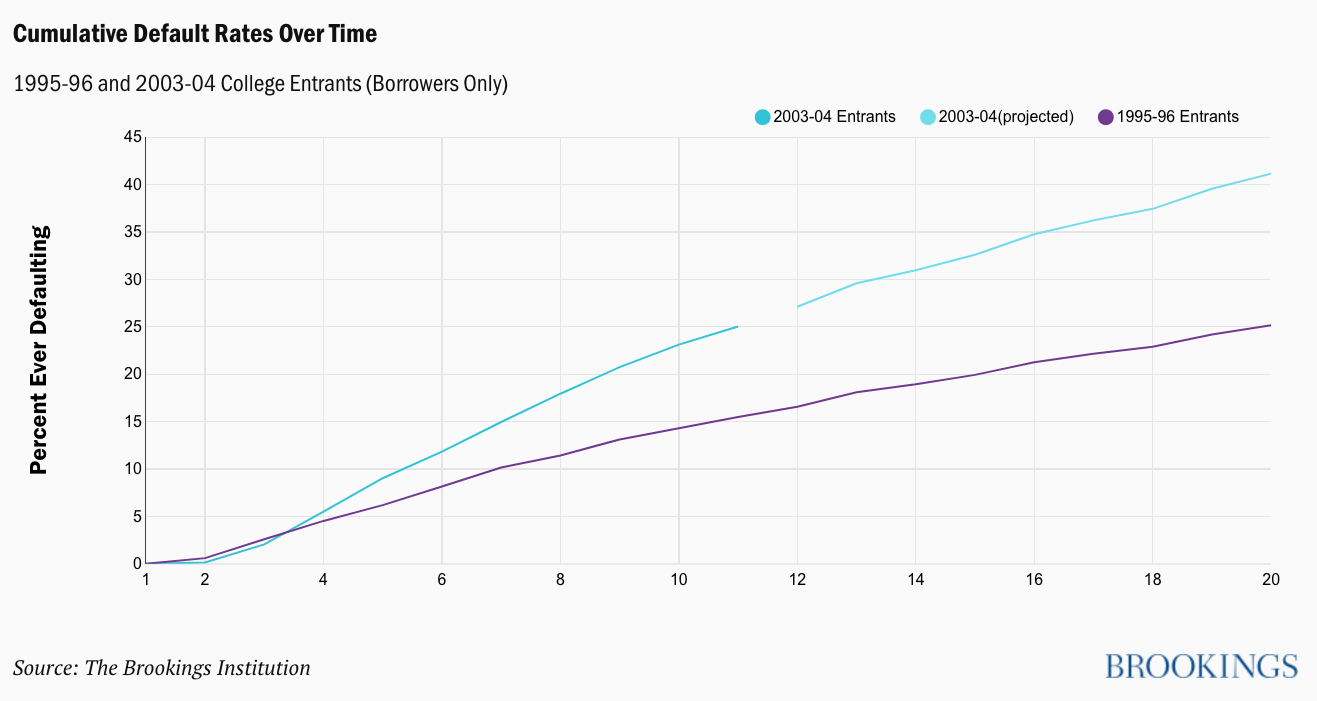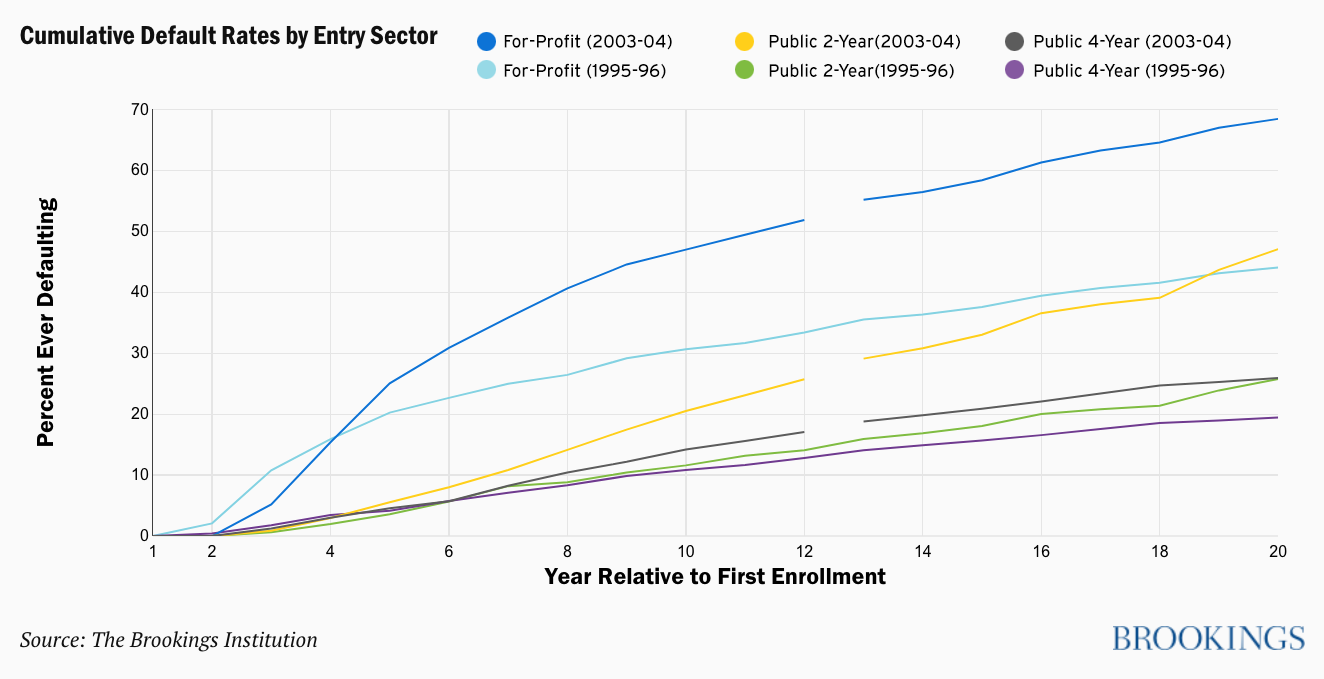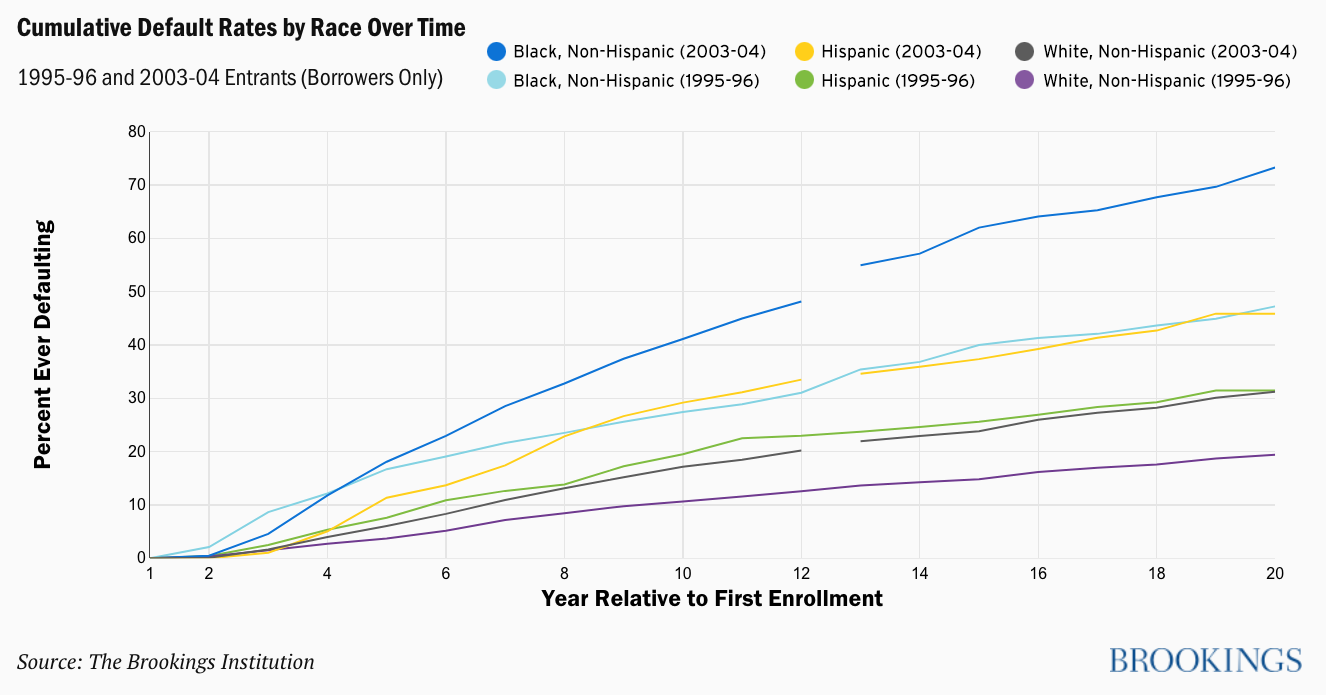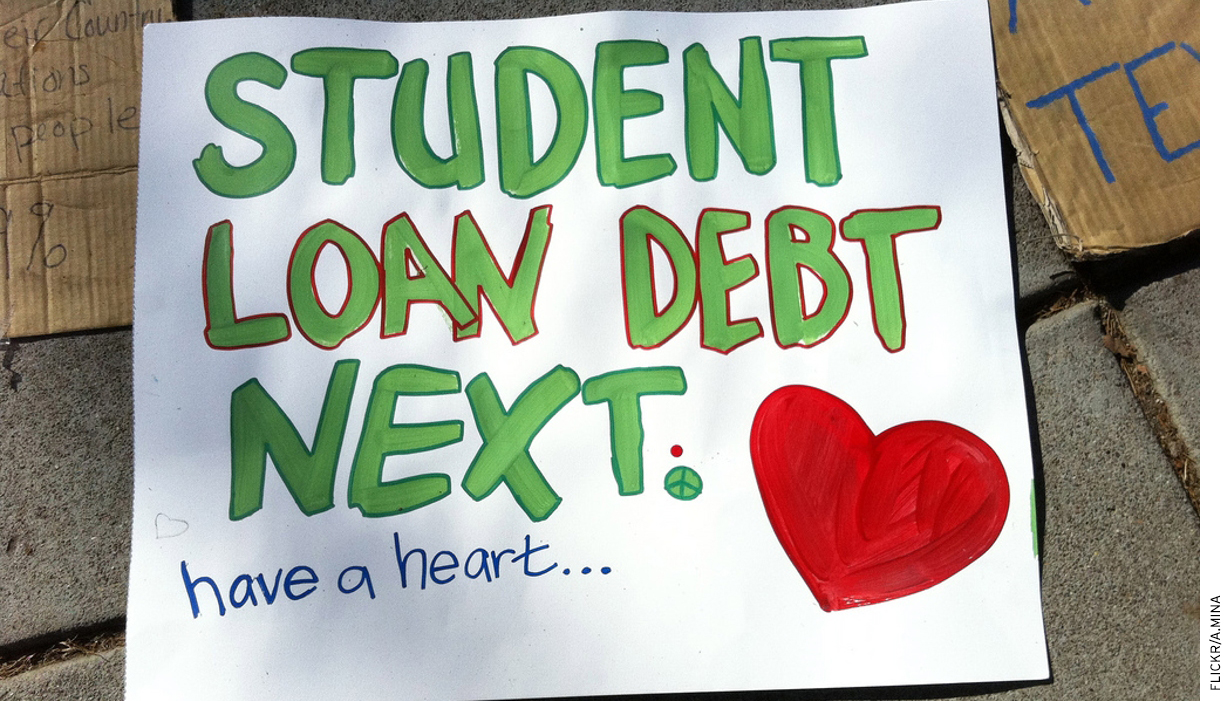
Executive summary
This report analyzes new data on student debt and repayment, released by the U.S. Department of Education in October 2017. Previously available data have been limited to borrowers only, follow students for a relatively short period (3-5 years) after entering repayment, and had only limited information on student characteristics and experiences. The new data allow for the most comprehensive assessment to date of student debt and default from the moment students first enter college, to when they are repaying loans up to 20 years later, for two cohorts of first-time entrants (in 1995-96 and 2003-04). This report provides a broader perspective on student debt and default that considers all college entrants rather than just borrowers, provides substantially longer follow-up, and enables a more detailed analysis of trends over time and heterogeneity across subgroups than previously possible.
Key findings from new analysis of these data include:
• Trends for the 1996 entry cohort show that cumulative default rates continue to rise between 12 and 20 years after initial entry. Applying these trends to the 2004 entry cohort suggests that nearly 40 percent may default on their student loans by 2023.
• The new data show the importance of examining outcomes for all entrants, not just borrowers, since borrowing rates differ substantially across groups and over time. For example, for-profit borrowers default at twice the rate of public two-year borrowers (52 versus 26 percent after 12 years), but because for-profit students are more likely to borrow, the rate of default among all for-profit entrants is nearly four times that of public two-year entrants (47 percent versus 13 percent).
• The new data underscore that default rates depend more on student and institutional factors than on average levels of debt. For example, only 4 percent of white graduates who never attended a for-profit defaulted within 12 years of entry, compared to 67 percent of black dropouts who ever attended a for-profit. And while average debt per student has risen over time, defaults are highest among those who borrow relatively small amounts.
• Debt and default among black college students is at crisis levels, and even a bachelor’s degree is no guarantee of security: black BA graduates default at five times the rate of white BA graduates (21 versus 4 percent), and are more likely to default than white dropouts.
• Trends over time are most alarming among for-profit colleges; out of 100 students who ever attended a for-profit, 23 defaulted within 12 years of starting college in the 1996 cohort compared to 43 in the 2004 cohort (compared to an increase from just 8 to 11 students among entrants who never attended a for-profit).
The results suggest that diffuse concern with rising levels of average debt is misplaced. Rather, the results provide support for robust efforts to regulate the for-profit sector, to improve degree attainment and promote income-contingent loan repayment options for all students, and to more fully address the particular challenges faced by college students of color.
Background and data
Until recently, the dominant focus of public concern around student loans has been simply how much of it there is, and how rapidly it has been growing over time. At nearly $1.4 trillion in loans outstanding, student debt is now the second-largest source of household debt (after housing) and is the only form of consumer debt that continued to grow in the wake of the Great Recession. [1]
But as many observers have noted, these aggregate statistics tell us little about the student-level experience with college debt. About one-quarter of the aggregate increase in student loans since 1989 is due to more students enrolling in college. [2] More recent work that tracks debt outcomes for individual borrowers documents that the main problem is not high levels of debt per student (in fact, defaults are lower among those who borrow more, since this typically indicates higher levels of college attainment), but rather the low earnings of dropout and for-profit students, who have high rates of default even on relatively small debts.[3]
This study utilizes new data, released by the U.S. Department of Education in October 2017, linking two waves of the Beginning Postsecondary Student (BPS) survey, a nationally-representative survey of first-time college beginners, to administrative data on debt and defaults. [4] This allows for the most comprehensive assessment yet of student debt and default from the moment students first enter college, to when they are repaying loans up to 20 years later, for two cohorts of first-time entrants (1995-96 and 2003-04 entrants, which I refer to as the BPS-96 and BPS-04 as shorthand). [5]
This allows for a broader perspective that considers all first-time college entrants rather than just borrowers, provides substantially longer follow-up than other data sources, and enables a more detailed analysis of trends over time and heterogeneity across subgroups. [6]
How debt and default evolve over time, by entry cohort
The best prior estimates of overall default rates come from Looney and Yannelis (2015), who examine defaults up to five years after entering repayment, and Miller (2017), who uses the new BPS-04 data to examine default rates within 12 years of college entry. These two sources provide similar estimates: about 28 to 29 percent of all borrowers ultimately default.
But even 12 years may not be long enough to get a complete picture of defaults. The new data also allow loan outcomes to be tracked for a full 20 years after initial college entry, though only for the 1996 entry cohort. Still, examining patterns of default over a longer period for the 1996 cohort can help us estimate what to expect in the coming years for the more recent cohort.
If we assume that the cumulative defaults grow at the same rate (in percentage terms) for the 2004 cohort as for the earlier cohort, we can project how defaults are likely to increase beyond year 12 for the 2004 cohort. To compute these projections, I first use the 1996 cohort to calculate the cumulative default rates in years 13-20 as a percentage of year 12 cumulative default rates. I then take this percentage for years 13-20 and apply it to the 12-year rate observed for the 2004 cohort. So, for example, since the 20-year rate was 41 percent higher than the 12-year rate for the 1996 cohort, I project the Year 20 cumulative default rate for the 2004 cohort is projected to be 41 percent higher than its 12-year rate.
Figure 1 plots the resulting cumulative rates of default relative to initial entry for borrowers in both cohorts, with the data points after year 12 for the 2003-04 cohort representing projections. Defaults increase by about 40 percent for the 1995-96 cohort between years 12 and 20 (rising from 18 to 26 percent of all borrowers). Even by year 20, the curve does not appear to have leveled off; it seems likely that if we could track outcomes even longer, the default rate would continue to rise.
For the more recent cohort, default rates had already reached 27 percent of all borrowers by year 12. But based on the patterns observed for the earlier cohort, a simple projection indicates that about 38 percent of all borrowers from the 2003-04 cohort will have experienced a default by 2023.
Figure 1
Source: Author’s calculations using NCES Power Stats with BPS-96 and BPS-04 data.
Of course, it is possible that the trends for the recent cohort may not follow the same path as the earlier one. The peak unemployment rates of the Great Recession hit in 2009-10, corresponding to Years 6-7 of the recent cohort and Years 14-15 of the earlier cohort. This could lead us to overestimate how many students from the 2003-04 cohort will experience defaults in the coming years. On the other hand, it’s also possible defaults could rise more than expected for the recent cohort: students in the recent cohort are taking longer to default than in the past. This can be seen in Figure 1, in which default rates for the recent cohort are actually slightly lower in Years 2-4 than for the earlier cohort. Among students who defaulted within 12 years, the median length to default once in repayment was 2.1 years for the earlier cohort but 2.8 years for the more recent cohort. [7]
Table 1 provides cross-cohort comparisons and projections over a 20-year time frame for defaults as well as additional measures of borrowing and repayment. [8] Figure 1 focuses on borrowers only, which is common when analyzing default rates. But because of increases in borrowing rates across cohorts, restricting the analysis to borrowers only can understate the full extent of heterogeneity across groups and time periods. For example, Table 1 shows that while 12-year default rates have risen by nearly 50 percent among borrowers (18 to 27 percent), they have risen by 71 percent if we consider all entrants (from 10 to 17 percent).
The value of computing outcomes across all entrants, not just borrowers, is particularly evident when examining heterogeneity across demographic and institutional subgroups. For example, for the 2003-04 cohort, the default rate among borrowers was about twice as high at for-profits as at public two-year institutions (52 percent versus 26 percent). But since less than half of community college entrants ever borrow, compared with nearly 90 percent of for-profit entrants, this understates the differences between these sectors. For-profit entrants default at nearly four times the rate of community college entrants (48 percent versus 13 percent, see Table 2).
Table 1
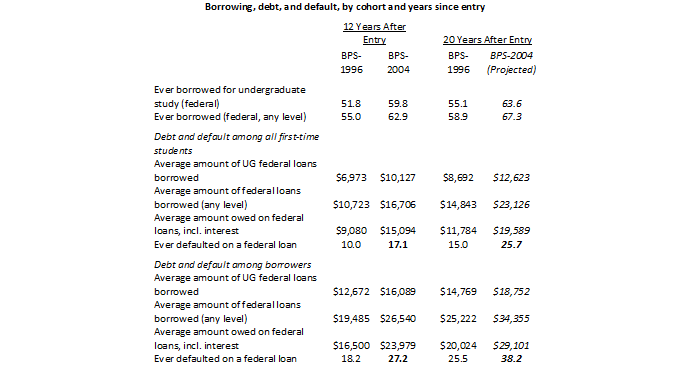
Source: Author’s calculations using NCES Power Stats with BPS-96 and BPS-04 data.Notes: Dollar amounts are not inflation-adjusted. Analyses are weighted to reflect sample that responded to the 6-year follow up survey (WTD000 for BPS-96 and WTA000 for BPS-04). Projections for BPS 2004 20-year outcomes based on 12-to-20 year percent increases for the 1996 cohort.
Heterogeneity by institution type, attainment, and race/ethnicity
In their analysis of three-year cohort default rates, Looney and Yannelis (2015) highlight the rapid increases in defaults among borrowers in the for-profit sector, and to a lesser extent among community college borrowers. I cut the data by institution type as well as by attainment status and race/ethnicity, two important variables that are unavailable in the Looney and Yannelis (2015) analysis. Table 2 shows 12-year borrowing rates, average amounts owed, and default rates among all first-time students, by each of these subgroups.
Table 2
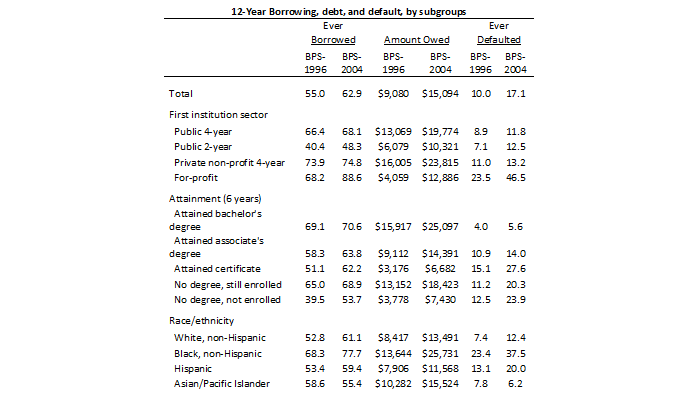
Source: Author’s calculations using NCES Power Stats with BPS-96 and BPS-04 data. Notes: Statistics computed across all first-time entrants. Amounts owed and default rates can be divided by the borrowing rate for the relevant group, to obtain statistics for borrowers only.
The table confirms that the growth in default rates across cohorts has been remarkably concentrated among for-profit entrants. In fact, the trends here are even more stark than found by Looney and Yannelis (2015), due in part to the large and rapidly growing differences in borrowing rates across sectors. Among all new students entering the for-profit sector in 2004, nearly half had defaulted within 12 years (47 percent), compared to “just” 24 percent in the 1996 cohort. The default rate for for-profit entrants is nearly four times the rate seen in other sectors, where only 12 to 13 out of every 100 entrants default. Figure 2, which focuses on borrowers only and projects default rates out to year 20, suggests that default rates in the for-profit sector could ultimately approach 70 percent.
Figure 2
Source: Author’s calculations using NCES Power Stats with BPS-96 and BPS-04 data.
Defaults have also risen most rapidly among students who never complete an associate’s or bachelor’s degree. While much attention has been given to the high rates of default among dropouts (24 percent), defaults are actually even higher among those who complete a postsecondary certificate (28 percent). This is despite relatively low levels of average debt in these groups. Though not shown in the table, the new data confirm a previously-documented pattern that defaults are highest among those with small debts: 37 percent of those who borrow between $1 and $6,125 for undergraduate study default within 12 years, compared with 24 percent of those who borrow more than $24,000.
While prior work has raised alarm bells about the crisis for African-American borrowers (Miller, 2017), the new data should ring the alarm even louder. As shown in Table 2, nearly 38 percent of all black first-time college entrants in 2004 had defaulted within 12 years, a rate more than three times higher than their white counterparts, and 13 percentage points higher than black students entering just eight years prior. Focusing on borrowers only and projecting default rates out through year 20 (as shown in Figure 3) suggests that 70 percent of black borrowers may ultimately experience default.
Figure 3
Source: Author’s calculations using NCES Power Stats with BPS-96 and BPS-04 data.
The special case of black BA graduates
Unlike for other demographic groups, for black students the debt crisis is not limited to dropouts and for-profit entrants. In a previous Brookings report (October 2016), co-author Jing Li and I highlight the black-white gap in student loan debt among bachelor’s degree (BA) graduates, and show how the gap widens in the four years following graduation. [9]
The newly released data tracking entrants for 12 years allow the tracking of BA graduates for an even longer follow-up (for the vast majority who take less than 8 years to complete their BA), and produce even more alarming results. While our previous report found that the black-white gap in total debt tripled after graduation, Table 3 below shows that with longer follow up the gap more than quadruples, from $10,301 at graduation to $43,372 at the end of the 12-year follow-up. The increasing gap over time is due both to higher levels of graduate school borrowing among black BA completers, as well as lower rates of repayment.
While BA completers as a whole default at a low rate (of just six out of every 100, see Table 2), the default rate among black graduates is more than five times the rate of white graduates (21 versus 4 percent). In fact, a black BA graduate is more likely to default than a white college dropout (21 versus 18, not shown).
The outcomes of black BA graduates cannot be explained solely by lower levels of parental income or education. The default rate of black graduates is significantly higher than the default rate for first generation, low-income graduates (13 percent, not shown in table). Scott-Clayton and Li (2016) provide evidence that poorer labor market outcomes and for-profit enrollment at the graduate level contribute to high rates of default among black college graduates.
Table 3
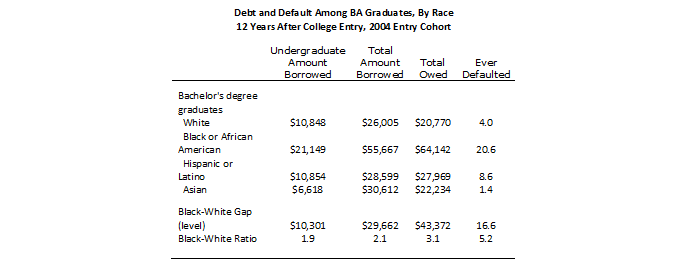
Source: Author’s calculations using NCES Power Stats with BPS-04 data.
The world outside the for-profits
The high concentration of defaults in the for-profit sector raises the question: how different would the overall patterns look, if we set aside the for-profits? In Table 4, I split the sample into those who never attended, versus ever attended a for-profit college. [10] Doing so shows that outside the for-profit sector, the changes over time have been much more modest. Default rates overall increased by just 3 students out of every 100 (from 8 to 11) outside the for-profit sector. Among black students, default rates increased by 8 students per 100 (from 20 to 28) outside the for-profit sector, compared to an increase of 21 students per 100 among those who ever attended a for-profit college.
For-profit enrollment contributes to defaults even among students initially starting at community colleges, due to subsequent transfers. If not for students later attending for-profits, community college entrants would have lower default rates than public four-year entrants.
The contrast across subgroups in the 2004 data is even more stark if we consider race, degree attainment, and institution sector simultaneously: only 4 percent of white graduates who never attended a for-profit defaulted within 12 years of entry, compared to 67 percent of black dropouts who ever attended a for-profit (not shown in table).
Table 4
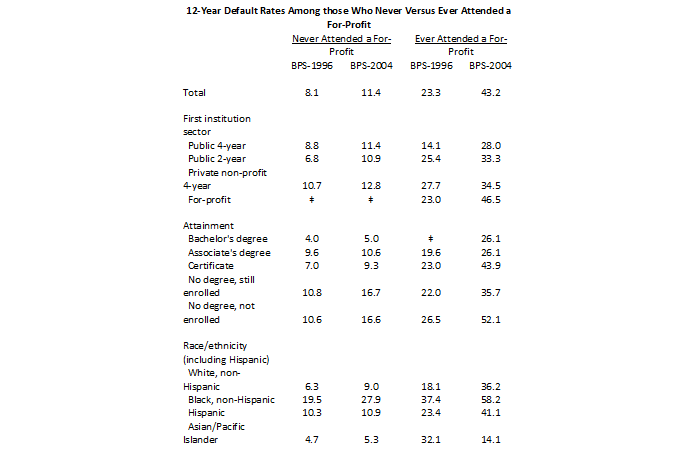
Source: Author’s calculations using NCES Power Stats with BPS-96 and BPS-04 data.
Conclusion
The analyses presented above highlight the value of tracking individual students from the beginning of their college trajectory for many years beyond when they leave school, and the importance of disaggregating trends by student and institutional characteristics. Key findings include:
• Trends for the 1996 entry cohort show that cumulative default rates continue to rise between 12 and 20 years after initial entry. Applying these trends to the 2004 entry cohort suggests that nearly 40 percent may default on their student loans by 2023.
• The new data show the importance of examining outcomes for all entrants, not just borrowers, since borrowing rates differ substantially across groups and over time. For example, for-profit borrowers default at twice the rate of public two-year borrowers (52 versus 26 percent after 12 years), the rate of default among all for-profit entrants is nearly four times that of public two-year entrants (47 percent versus 13 percent).
• The new data underscore that default rates depend more on student and institutional factors than on average levels of debt. For example, only 4 percent of white graduates who never attended a for-profit defaulted within 12 years of entry, compared to 67 percent of black dropouts who ever attended a for-profit. And while average debt per student has risen over time, defaults are highest among those who borrow relatively small amounts.
• Debt and default among black or African-American college students is at crisis levels, and even a bachelor’s degree is no guarantee of security: black BA graduates default at five times the rate of white BA graduates (21 versus 4 percent), and are more likely to default than white dropouts.
• Trends over time are most alarming among for-profit colleges; out of 100 students who started college at a for-profit, 23 defaulted within 12 years of starting college in the 1996 cohort compared to 43 in the 2004 cohort (compared to an increase from just 8 to 11 students among entrants who never attended a for-profit).
The data used here are not without their own limitations. For example, the BPS considers only first-time beginning college students – but older, returning students borrow too and may have worse outcomes. [11] Graduate students also represent a growing share of student debt. Further, even the 2004 cohort considered here predates the rapid growth in for-profit enrollment during the recession. If the Department of Education linked the administrative data on debt and repayment used here to the National Postsecondary Student Aid Survey (NPSAS) survey as well, the analyses above could be extended to a broader and more recent population of students.
To conclude, the results suggest that diffuse concern with rising levels of average debt is misplaced. Rather, the results provide support for robust efforts to regulate the for-profit sector, to improve degree attainment and promote income-contingent loan repayment options for all students, and to more fully address the particular challenges faced by college students of color.
— Judith Scott-Clayton
 Judith Scott-Clayton is Associate Professor of Economics and Education at Teachers College, Columbia University.
Judith Scott-Clayton is Associate Professor of Economics and Education at Teachers College, Columbia University.
This post originally appeared as part of Evidence Speaks, a weekly series of reports and notes by a standing panel of researchers under the editorship of Russ Whitehurst.
The author(s) were not paid by any entity outside of Brookings to write this particular article and did not receive financial support from or serve in a leadership position with any entity whose political or financial interests could be affected by this article.
Editor’s Note:“BA” is used to refer to all undergraduate bachelor’s degrees.
Notes:
1. Federal Reserve Bank of New York, Quarterly Report on Household Debt and Credit. URL: https://www.newyorkfed.org/microeconomics/hhdc.html accessed on January 8, 2018.
2. Beth Akers and Matthew M. Chingos (2014), Is a Student Loan Crisis on the Horizon?, Brookings Report, https://www.brookings.edu/research/is-a-student-loan-crisis-on-the-horizon/.
3. Adam Looney and Constantine Yannelis (2015), A crisis in student loans? How changes in the characteristics of borrowers and in the institutions they attended contributed to rising loan defaults, Brookings Papers onn Economic Activity, https://www.brookings.edu/bpea-articles/a-crisis-in-student-loans-how-changes-in-the-characteristics-of-borrowers-and-in-the-institutions-they-attended-contributed-to-rising-loan-defaults/; Susan M. Dynarski (2016), The trouble with student loans? Low earnings, not high debt, Brookings Evidence Speaks Report, https://www.brookings.edu/research/the-trouble-with-student-loans-low-earnings-not-high-debt/ ;
4. Survey participants are surveyed at baseline, and again three and six years after entry. Administrative records are also collected to document persistence and attainment as well as financial aid receipt up to six years after initial entry. In 2017, the BPS-96 and BPS-04 samples were matched to administrative records on loan repayment from the National Student Loan Data System (NSLDS) through 2015. This allows repayment outcomes to be tracked for up to 20 years post-entry for the 1996 cohort, and up to 12 years post-entry for the 2004 cohort. BPS-04 estimates are weighted by the NCES-provided baseline weight, WTA000, while BPS-96 estimates are weighted by WTD000. These are the same weights used in the Department of Education’s own “First Look” report that comparesoutcomes across the two survey waves (Woo et al., 2017). The statistics presented here will also differ from the “cohort default rates” analyzed by Looney & Yannelis (2015) and used by the Department of Education for accountability purposes, which track borrowers for three years once they enter repayment. This analysis tracks defaults up to 12 or 20 years after initial entry, regardless of when the student initially entered repayment.
5. Only three other reports so far have made use of these new data. Jennie H. Woo et al. (2017) focus on trends over time in Repayment of Student Loans as of 2015 Among 1995-96 and 2003-04 First-Time Beginning Students, a First Look report (NCES 2018-410), U.S. Department of Education. Ben Miller (October 2017) focuses on racial gaps in the 2003-04 cohort in New Federal Data Show a Student Loan Crisis for African American Borrowers, Center for American Progress, https://www.americanprogress.org/issues/education-postsecondary/news/2017/10/16/440711/new-federal-data-show-student-loan-crisis-african-american-borrowers/ and Ben Miller (December 2017) examines characteristics of defaulters in the 2003-04 cohort in Who Are Student Loan Defaulters?, https://www.americanprogress.org/issues/education-postsecondary/reports/2017/12/14/444011/student-loan-defaulters/
6. Though I begin by looking at outcomes among borrowers, for most of the report I will focus on default rates and debt burdens among all entrants of a given cohort and demographic group, including those who never borrowed. This is because the rate at which students borrow at all varies significantly across demographic groups, institutional sectors, and over time. Conditioning the analysis on borrowers only thus tends to mute these important patterns of heterogeneity. To obtain the default rates among borrowers only, readers can divide the overall default rate by the percent of students who borrowed.
7. Median time to first entering repayment has remained stable at approximately 2.5 years after college entry, for both cohorts.
8. Note that slight discrepancies between Figure 1 and the estimated 12- and 20-year default rates among borrowers shown in table 1 are due to the fact that the precise timing of defaults is unknown for a small fraction of defaulters, who are included in Table 1 but excluded from Figure 1.
9. Judith Scott-Clayton and Jing Li (2016), “Black-white disparity in student loan debt more than triples after graduation,” Evidence Speaks Reports 2 (3). Washington, DC: The Brookings Institution. URL: https://www.brookings.edu/wp-content/uploads/2016/10/es_20161020_scott-clayton_evidence_speaks1.pdf
10. Unfortunately, for the 1996 cohort this variable is only available at the 3-year follow up, so it is possible that the 1996 figures may still include some students who later enrolled in a for-profit.
11. In the Department of Education’s broadest survey of postsecondary students, the National Postsecondary Student Aid Survey (NPSAS), about 20 percent of students classified as “first year undergraduates” first enrolled in college five or more years prior. This is one reason why the loan statistics in these data will not align precisely with Looney & Yannelis (2015).


